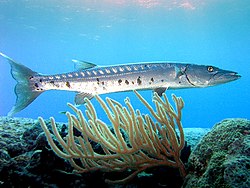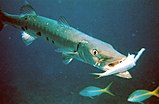Barracuda
| Barracuda | |
|---|---|

| |
| Sphyraena barracuda in Saba, Netherlands Antilles | |
| Scientific classification | |
| Domain: | Eukaryota |
| Kingdom: | Animalia |
| Phylum: | Chordata |
| Class: | Actinopterygii |
| Order: | Istiophoriformes |
| Family: | Sphyraenidae Rafinesque, 1815 |
| Genus: | Sphyraena J. T. Klein, 1778 |
| Type species | |
| Esox sphyraena | |
A barracuda, or cuda for short, is a large, predatory, ray-finned fish known for its fearsome appearance and ferocious behaviour. The barracuda is a saltwater fish of the genus Sphyraena, the only genus in the family Sphyraenidae which was named by Constantine Samuel Rafinesque in 1815.[2] It is found in tropical and subtropical oceans worldwide ranging from the eastern border of the Atlantic Ocean to the Red Sea, on its western border the Caribbean Sea, and in tropical areas of the Pacific Ocean. Barracudas reside near the top of the water and near coral reefs and sea grasses.[3] Barracudas are targeted by sport-fishing enthusiasts.
Description

Barracuda are snake-like in appearance, with prominent, sharp-edged, fang-like teeth, much like piranha, all of different sizes, set in sockets of their large jaws. They have large, pointed heads with an underbite in many species. Their gill covers have no spines and are covered with small scales. Their two dorsal fins are widely separated, with the anterior fin having five spines, and the posterior fin having one spine and 9 soft rays. The posterior dorsal fin is similar in size to the anal fin and is situated above it. The lateral line is prominent and extends straight from head to tail. The spinous dorsal fin is placed above the pelvic fins and is normally retracted in a groove. The caudal fin is moderately forked with its posterior edged double-curved and is set at the end of a stout peduncle. The pectoral fins are placed low on the sides. The swim bladder is large, allowing for minimal energy expenditure while cruising or remaining idle. [4]
In most cases, barracuda are dark gray, dark green, white, or blue on the upper body, with silvery sides and a chalky-white belly. Coloration varies somewhat between species. For some species, irregular black spots or a row of darker cross-bars occur on each side. Their fins may be yellowish or dusky. Barracudas live primarily in oceans, but certain species, such as the great barracuda, live in brackish water.
Some species grow quite large (up to 65 inches or 165 cm in length),[5] such as Sphyraena sphyraena, found in the Mediterranean Sea and eastern Atlantic; Sphyraena picudilla, ranging on the Atlantic coast of tropical America from North Carolina to Brazil and reaching Bermuda. Other barracuda species are found around the world. Examples are Sphyraena argentea, found from Puget Sound southwards to Cabo San Lucas, Sphyraena jello, from the seas of India and the Malay Peninsula and Archipelago.
Species
28 species in this genus are recognized:
- Sphyraena arabiansis E. M. Abdussamad, Ratheesh, Thangaraja, Bineesh & D. Prakashan, 2015 (Arabian barracuda) [6]
- Sphyraena acutipinnis F. Day, 1876 (Sharpfin barracuda)
- Sphyraena afra W. K. H. Peters, 1844 (Guinean barracuda)
- Sphyraena argentea Girard, 1854 (Pacific barracuda)
- Sphyraena barracuda (G. Edwards, 1771) (Great barracuda)
- Sphyraena borealis DeKay, 1842 (Northern sennet)
- Sphyraena chrysotaenia Klunzinger, 1884 (Yellowstripe barracuda)
- Sphyraena ensis D. S. Jordan & C. H. Gilbert, 1882 (Mexican barracuda)
- Sphyraena flavicauda Rüppell, 1838 (Yellowtail barracuda)
- Sphyraena forsteri G. Cuvier, 1829 (Bigeye barracuda)
- Sphyraena guachancho G. Cuvier, 1829 (Guachanche barracuda)
- Sphyraena helleri O. T. Jenkins, 1901 (Heller's barracuda)
- Sphyraena iburiensis Doiuchi & Nakabo, 2005
- Sphyraena idiastes Heller & Snodgrass, 1903 (Pelican barracuda)
- Sphyraena intermedia Pastore, 2009 [7]
- Sphyraena japonica Bloch & J. G. Schneider, 1801 (Japanese barracuda)
- Sphyraena jello G. Cuvier, 1829 (Pickhandle barracuda)
- Sphyraena lucasana T. N. Gill, 1863 (Lucas barracuda)
- Sphyraena novaehollandiae Günther, 1860 (Australian barracuda)
- Sphyraena obtusata G. Cuvier, 1829 (Obtuse barracuda)
- Sphyraena picudilla Poey, 1860 (Southern sennet)
- Sphyraena pinguis Günther, 1874 (Red barracuda)
- Sphyraena putnamae D. S. Jordan & Seale, 1905 (Sawtooth barracuda)
- Sphyraena qenie Klunzinger, 1870 (Blackfin barracuda)
- Sphyraena sphyraena (Linnaeus, 1758) (European barracuda)
- Sphyraena tome Fowler, 1903
- Sphyraena viridensis G. Cuvier, 1829 (Yellowmouth barracuda)
- Sphyraena waitii W. Ogilby, 1908
Behavior and diet
Barracudas are ferocious, opportunistic predators, relying on surprise and short bursts of speed, up to 27 mph (43 km/h),[8] to overtake their prey.
Adults of most species are more or less solitary, while young and half-grown fish frequently congregate. Barracudas prey primarily on fish (which may include some as large as themselves). They kill and consume larger prey by tearing chunks out of their prey. Barracuda species are often seen competing against mackerel, needle fish and sometimes even dolphins for prey.[3]
Barracuda feed on an array of prey including fish such as jacks, grunts, groupers, snappers, small tunas, mullets, killifishes, herrings, and anchovies by simply biting them in half.[9] They also seem to consume smaller species of sustenance that are in front of them.
Barracudas are usually found swimming in saltwater searching for schools of plankton-feeding fish. Their silver and elongated bodies make them difficult for prey to detect, and even more difficult to be seen when viewing them head-on. Barracudas depend heavily on their eyesight when they are out hunting. When hunting, they tend to notice everything that has an unusual color, reflection, or movement. Once a barracuda targets an intended victim, its long tail and matching anal and dorsal fins enable it to move with swift bursts of speed to attack its prey before it can escape. Barracudas generally attack schools of fish, speeding at them head first and biting at them with their jaws. When barracudas age, they tend to swim alone. However, there are times where they tend to stay with the pack. Barracudas will sometimes swim in groups. In this case, they can relocate schools of fish into compact areas or lead them into shallow water to more easily feed on them.[10]
Interactions with humans
Some species of barracuda are reputed to be dangerous to swimmers. Barracudas are scavengers, and may mistake snorkellers for large predators, following them hoping to eat the remains of their prey. Swimmers have reported being bitten by barracudas, but such incidents are rare and possibly caused by poor visibility. Large barracudas can be encountered in muddy shallows on rare occasion. Barracudas may mistake things that glint and shine for prey.[11] One incident reported a barracuda jumping out of water and injuring a kayaker,[12] but Jason Schratwieser, conservation director of the International Game Fish Association, said that the wound could have been caused by a houndfish.[13]
As food
Barracudas are popular both as food and game fish. They are most often eaten as fillets or steaks. Larger species, such as the great barracuda, have been implicated in cases of ciguatera food poisoning.[14] Those who have been diagnosed with this type of food poisoning display symptoms of gastrointestinal discomfort, limb weakness, and an inability to differentiate hot from cold effectively.[9]
West Africans smoke them for use in soups and sauces. Smoking protects the soft flesh from disintegrating in the broth and gives it a smoky flavour.
In popular culture
The barracuda prominently appeared in the 2003 Disney/Pixar animated film Finding Nemo, in the beginning of the film, when it attacks the two clownfish Marlin (Albert Brooks), Coral (Elizabeth Perkins), Nemo (Alexander Gould) and their eggs who lives in the sea anemone by the drop off in the Great Barrier Reef in Austraila. Before the main titles in the film and in the 3D version release in 2012, the barracuda closes its teeth and the bottom lip is shown in the film.
The barracuda also appeared as an easter egg in the 2019 Disney/Pixar animated film Toy Story 4. It was stuffed and mounted in display in the Second Chances antique store.
Barracuda is the title of a 1977 hit song by American rock band Heart. [15]
The Pokémon Arrokuda and its evolution Barraskewda (both introduced to the franchise in Pokémon Sword and Shield) are based on the barracuda.
The Plymouth Barracuda is a two-door pony car that was manufactured by Plymouth from 1964 to 1974.
Gallery
-
Close-up of Sphyraena barracuda
-
Sphyraena barracuda with prey
-
School of Sphyraena qenie at Elphinstone Reef in the Red Sea
-
A battery of Sphyraena putnamae in Bora Bora
-
Sphyraena borealis
-
Woman carrying a barracuda in Madagascar
References
- ^ Sepkoski, J. (2002). "A compendium of fossil marine animal genera". Bulletins of American Paleontology. 363: 1–560. Archived from the original on 2011-07-23.
- ^ N. Bailly (2015). "Sphyraenidae Rafinesque, 1815". World Register of Marine Species. Retrieved 6 April 2017.
- ^ a b Millburn, N. "The Great Barracuda's Diet". Animals - PawNation. Archived from the original on 2013-12-03.
- ^ "Barracuda | fish". Encyclopedia Britannica. Retrieved 2019-05-03.
- ^ Fischer, W. (1987). Guide Fao d'Identification des Espèces pour les Besoins de la Pêche Volume 2: Vertébrés. Rome: Laboratoire d’Ichtyologie générale et appliquée Muséum national d’Histoire naturelle. pp. ftp://ftp.fao.org/docrep/fao/009/x0170f/x0170f82.pdf.
- ^ Abdussamad, E.M.; Retheesh, T.B.; Thangaraja, R.; Bineesh, K.K.; Prakashan, D. (2015). "Sphyraena arabiansis a new species of barracuda (Family: Sphyraenidae) from the south-west coast of India". Indian Journal of Fisheries. 62 (2): 1–6.
- ^ Pastore, M.A. (2009). "Sphyraena intermedia sp. nov. (Pisces: Sphyraenidae): a potential new species of barracuda identified from the central Mediterranean Sea". Journal of the Marine Biological Association of the United Kingdom. 89 (6): 1299–1303. doi:10.1017/s0025315409000575.
- ^ Martin, R.A. "What's the Speediest Marine Creature?". ReefQuest Centre for Shark Research.
- ^ a b "Barracuda Fish Facts". AtlanticPanic.
- ^ "Barracuda - Predatory Behavior". science.jrank.org. Retrieved 2019-05-04.
- ^ Bester, C. "Great barracuda". Florida Museum of Natural History Ichthyology Department. Archived from the original on 2016-01-26. Retrieved 2009-08-28.
- ^ Fletcher, p. (2010). Marshall, J. (ed.). "Jumping barracuda injures kayaker off Florida Keys". Reuters.
- ^ Fleshler, D.; Ortega, J. (2010). "Leaping fish punctures lung of woman kayaking in Keys". Sun Sentinel.
- ^ "Hazard, Market, Geographic and Nomenclature Information for Great Barracuda". Regulatory Fish Encyclopedia (RFE). U.S. Food & Drug Administration. 2002. Archived from the original on 2003-02-26.
- ^ Rath, Zoë (2016). "Hit Songs Deconstructed". Notes. 73 (2): 327–330. doi:10.1353/not.2016.0142. ISSN 1534-150X. S2CID 191805608.







